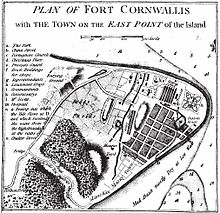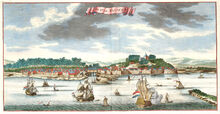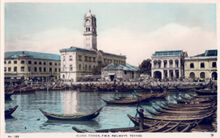The Straits Settlements, comprising Penang, Singapore and Malacca, were British crown colonies located along the Straits of Malacca. The three territories were governed under a single administrative unit, firstly by the British East India Company and then by the British government, between 1826 and 1946.
Prior to the establishment of the Straits Settlement in 1826, each of the three British possessions were governed separately. The Straits Settlement was founded as a presidency. However, it soon came under the administration of the Bengal Presidency in India.
Growing discontent over India-centric policies led to the Straits Settlements becoming a British crown colony in 1867. The crown colony was ruled directly by the Colonial Office in London and headed by a Governor.
As with the rest of British Malaya, the Straits Settlements fell to the Japanese Empire during World War 2. In 1946, after the return of the British, the Straits Settlements were dissolved. Penang and Malacca being absorbed into the Malayan Union, which eventually evolved into the Federation of Malaya. Singapore remained a British crown colony until 1963, when it merged with the Federation to form Malaysia, from which it gained independence in 1965.
History[]
| Event | Date |
|---|---|
| Founding of George Town | 11 August 1786 |
| Founding of Singapore | 6 February 1819 |
| British acquisition of Malacca | 17 March 1824 |
| Establishment of the Straits Settlements | 1 August 1826 |
| Direct rule by the British crown | 1 April 1867 |
| Dissolution | 1 April 1946 |
Background[]

An 1800 map of George Town
While George Town, founded in 1786 by Captain Francis Light, succeeded as a British trading port and shipyard, its location near the northern end of the Straits of Malacca did not support British strategic interests in Southeast Asia. Trade with Qing China required a port at the southern end of the Straits of Malacca, where shipping routes converged and brought a heavy flow of vessels.

George Town in the early 19th. century
Recognising this need, Sir Thomas Stamford Raffles founded the island of Singapore just off the southern tip of the Malay Peninsula. Having obtained the rights to establish a port from the ruling Sultanate of Johor in 1819, the British East India Company gained complete control of Singapore in 1824.

Singapore in the early 19th. century
Also, the Anglo-Dutch Treaty of 1824 led to the British acquisition of the former Dutch colony of Malacca, in exchange for Bencoolen in Sumatra. In addition, the treaty divided the Malay archipelago into British and Dutch spheres of influence - the British would dominate the territories north of the Straits of Singapore, while the Dutch remained in control to the south, eventually forming the Dutch East Indies (now Indonesia).

Prior to the Anglo-Dutch Treaty of 1824, Malacca was a Dutch colony.
The three British East India Company possessions - Penang, Singapore and Malacca - were governed separately. This led to ballooning administration costs for the British East India Company, thus the decision was made to amalgamate the three territories into a single administrative unit.
Establishment[]
The Presidency of the Straits Settlements was established on 1 August 1826, comprising Penang (both the Prince of Wales Island and Province Wellesley), Singapore and Malacca. George Town was made the capital of the new entity, which meant that Singapore and Malacca officially became dependencies of Penang.
The Straits Settlements was headed by a Governor based in George Town, while a Resident Councillor was placed in charge of each of the three Settlements. However, as the Governor had to move often to the other two Settlements to deal with matters of state or to hold sessions of the Court of Judicature, the 'Seat of Government' would therefore move with the Governor. Meanwhile, the Recorder, representing the judicial authority of the Straits Settlements, was also based in George Town, with the court's jurisdiction being expanded to Singapore and Malacca.
Bengal Presidency[]
| Capital of the Straits Settlements | Period |
|---|---|
| George Town | 1826 - 1832 |
| Singapore | 1832 - 1946 |

An 1854 map of the Straits Settlements, as well as British Malaya
In 1830, just four years after its formation, the Straits Settlements came under the administration of the Bengal Presidency in India by the Company. This essentially reduced the status of the Straits Settlements from a separate presidency to one governed by a presidency based in India.
This move was intended to further reduce the Company's expenditure, as it did not have adequate revenue to run a new Presidency with a growing apparatus and judiciary. Prior to the abolishment of the Presidency, Lord W. Bentick, the then Governor-General of India, visited the Prince of Wales Island and famously remarked that he 'could not see what the island was like for the number of cocked hats that were in his way'.
With the change in status, the Governor was replaced with the Resident, who was assisted by an assistant resident and a deputy resident. The number of senior civil servants was cut and employment frozen.
Although the title of the Governor was reinstated in 1832, the executive powers were further concentrated in India the following year with the passing of the 1833 Charter Act. According to the act, the Governor was to report to the government in India instead of directly to the Company's board of directors in London.
By then, the growing importance of Singapore as a strategic British trading post led to the shifting of the administrative capital from Penang to Singapore. The judicial centre remained in George Town until 1856, when Singapore's new judicial authority began to subsume that of Penang. Penang thus suffered the humiliation of being subordinated to its upstart rival to the south.
Meanwhile, the authorities in Bengal used the Straits Settlements as a penal colony, shipping Indian convicts to the Settlements to satiate growing labour requirements. They also attempted to enforce policies that were detrimental to the economy of the Straits Settlements, such as the adoption of the Indian currency. Furthermore, the Straits Settlements were not represented in the Indian legislative council.
Crown Colony[]
The mercantile community within the Straits Settlements began agitating for direct rule by the British crown due to the indifference by the authorities in India. The Settlements had no representation in India and both entities used different currencies. Moreover, the practice of employing Indian convicts also caused minor uprisings in George Town and Singapore, and the authorities in India had done little to curb the increasingly rampant Chinese secret societies.
On 1 April 1867, the British government officially transferred the governance of the Straits Settlements to the Colonial Office in London. Hence, the Straits Settlements became a British crown colony.
With the change in status, the Governor now communicated directly with the secretary of state in the Colonial Office. The Governor was also vested with executive powers, and was now allowed to appoint judges and justices of peace. He was to be aided by an executive council and a legislative council, which included nominated unofficial members from the local communities.
20th. Century[]

Singapore in the early 20th. century possessed one of the busiest harbours in the world.
By the 1900s, the Straits Settlements was a relatively prosperous part of the British Empire. The Port of Singapore was the seventh busiest in the world by 1914, and the growth of rubber and tin industries within the Malay Peninsula expedited the increase in exports of these raw materials out of Singapore and George Town.

George Town in the 1900s
However, the economic prosperity was soon ended by the Global Depression in the 1930s. A decade later, as with the rest of British Malaya, all three Settlements fell to the invading forces of the Japanese Empire. George Town was captured by the Imperial Japanese Army on 19 December 1941, followed by Malacca on 15 January 1942 and Singapore on 15 February.
After the war's end, the returning British began to implement the reorganisation of British Malaya to ensure administrative efficiency and military security. Penang and Malacca were to be merged with the other nine Malay sultanates within the Malay Peninsula to form the Malayan Union. Singapore was to remain a British crown colony, as the British wanted to retain its naval base and free port. Furthermore, it was feared that Singapore's predominantly Chinese population would erode Malay support for the Malayan Union, given that all persons who were born or domiciled within the Malayan Union were automatically eligible for citizenship.
As a result, the Straits Settlements was finally dissolved by the British Parliament on 1 April 1946. Penang and Malacca were absorbed into the Malayan Union, which eventually gave way to the Federation of Malaya. Singapore remained a British crown colony until 1963, when it, along with Sarawak and North Borneo, merged with the Federation to form Malaysia. Singapore subsequently separated from Malaysia in 1965.
Governance[]
As a British crown colony, the Governor of the Straits Settlements was subordinate to the secretary of state in the Colonial Office in London. However, the Straits Settlements government under the Governor had the autonomy to formulate and pass laws relevant for the local conditions. The Governor was also vested with certain executive powers, such as the appointment of judges.

Soon after the Straits Settlements became a British crown colony in 1867, the Government House was built in Singapore. Today, it serves as the official residence of the President of the Republic of Singapore.
The Governor was assisted by an executive council and a legislative council. The Straits Settlements Executive Council, comprising the Governor, the commanding officer of all British Army units based within the Straits Settlements and six other senior officials, was the highest body of government within the Straits Settlements.
The Straits Settlements Legislative Council consisted of the members of the Executive Council, as well as the Chief Justice and four non-officials nominated from the local communities. The non-officials were intended to better represent the Asian communities within the Straits Settlements. Over the years, the number of non-officials grew, with most originating from Singapore. This frequently caused consternation from Penang and Malacca; Penangite politicians at one time demanded independence from Singapore.
While officials were obliged to support the Governor, the non-officials were allowed the freedom of speech and could vote as they wish. Although the Governor held the power of assent or veto on all bills, he was instructed to take note of the views of the Legislative Council, particularly when all the non-officials held an unanimous opinion on issues such as taxation and expenditure.
List of Governors[]
British East India Company[]
1826 - 1830 : Robert Fullerton
1830 - 1833 : Robert Ibbetson
1833 - 1836 : Kenneth Murchison
1836 - 1843 : Samuel George Bonham
1843 - 1855 : William John Butterworth
1855 - 1859 : Edmund Augustus Blundell
1859 - 1867 : William Orfeur Cavenagh
Crown Colony[]
1867 - 1873 : Harry St. George Ord
1873 - 1875 : Andrew Clarke
1875 - 1877 : William Francis Drummond Jervois
1877 - 1879 : William Cleaver Francis Robinson
1880 - 1887 : Frederick Aloysius Weld
1887 - 1893 : Cecil Clementi Smith
1893 - 1894 : William Edward Maxwell
1894 - 1899 : Charles Bullen Hugh Mitchell
1901 - 1904 : Frank Athelstane Swettenham
1904 - 1911 : John Anderson
1911 - 1919 : Arthur Henderson Young
1920 - 1927 : Laurence Nunns Guillemard
1927 - 1929 : Hugh Charles Clifford
1930 - 1934 : Cecil Clementi
1934 - 1946 : Thomas Shenton Whitelegge Thomas
Demographics[]
As of 1901, the census of the entire Straits Settlements is as follows.
| Territory | Europeans | Eurasians | Chinese | Malays | Indians | Other nationalities | Total |
|---|---|---|---|---|---|---|---|
| Singapore | 3,824 | 4,120 | 164,041 | 36,080 | 17,823 | 2,667 | 228,555 |
| Penang | 1,160 | 1,945 | 98,424 | 106,000 | 38,051 | 2,627 | 248,207 |
| Malacca | 74 | 1,598 | 19,468 | 72,978 | 1,276 | 93 | 95,487 |
| Total | 572,249 | ||||||
There were some notable differences in the societies of each Settlement. For example, the influx of Chinese immigrants was more pronounced in Singapore, where ethnic Chinese still make up over 70% of the population to this day, while Malacca had a large rural Malay population.
However, the one common aspect unique to the Straits Settlements is the prevalence of the Peranakans, who descended from mixed marriages between Chinese and Malays. The first Peranakans were believed to have lived in Malacca in the 15th. century, during the era of the Sultanate of Malacca. After the British East India Company established trading ports in George Town and Singapore, some of the Peranakans of Malacca moved to the other two Settlements. In addition, Chinese migrants in both George Town and Singapore married local wives, thus adding to the existing Peranakan communities.
During the British colonial era, the Peranakans were also known as the Straits Chinese, due to their loyalty to the British crown rather than China, and their multi-lingual abilities. The Peranakan culture was a hybrid of Malay and Chinese influences, aspects of which remain visible to this day in all three cities.
Other than the Peranakans, the Straits Settlements also have a greater proportion of Eurasians who descended from mixed marriages between Europeans and Asians. In particular, Malacca's Kristang community, whose ancestors were Portuguese and Asians, still exist to this day.
Monetary[]

One Straits dollar note

10 Straits dollar note
Between 1898 and 1939, the Straits Settlements issued its own currency, named the Straits dollar. It was also used in other parts of British Malaya, as well as Sarawak, Brunei and North Borneo.

One Malayan dollar note
The Straits dollar was replaced in 1939 with the Malayan dollar, which remained in legal tender until 1953.
References[]
- Barber, A., 2009. Penang under the East India Company 1786 - 1858. AB&A.
- Langdon, M., 2013. Penang : The Fourth Presidency of India 1805 - 1830. Areca Books.
- Yeoh S.G., Loh W.L., Khoo S.N., Neil K., 2009. Penang and Its Region : The Story of an Asian Entrepôt. National University of Singapore.
- http://eresources.nlb.gov.sg/infopedia/articles/SIP_2014-07-30_084623.html
- http://eresources.nlb.gov.sg/history/events/bd541c73-58ef-4bb1-9de7-173f00913286
- http://eresources.nlb.gov.sg/history/events/e9600931-19db-4a18-8366-8ae5aea35464
- http://eresources.nlb.gov.sg/history/events/cf47ce98-0e14-4c1f-a6f7-cb55c99b4df6
- http://eresources.nlb.gov.sg/history/events/e8db672a-3571-4fa3-9df0-220e83ee2a88